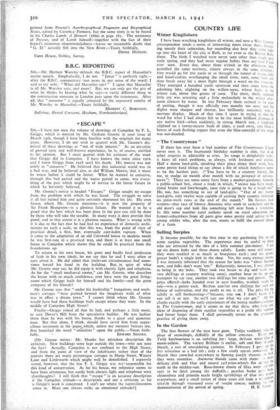I have been watching kingfishers all winter, and now a
West Country correspondent sends a series of interesting notes about them, discuss- ing mostly their coloration, but recording also how they come right up into the heart of the city at Bath, as far even as the Roman Baths there. The birds I watched were never seen other than singly until early spring, and they had more regular habits than any bird I had ever seen. Every day, about three o'clock in the afternoon, they patrolled the same territory, almost always in the' same direction.; they would go for zoo yards or so through the tunnel of young alder and hazel-catkins overhanging the small river, turn, come back and then break away for a short flight through a wood on the waterside. They emerged a hundred yards upstream and then came down the .adjoining lake, alighting on the willow-trees, whose buds, in the winter sun, shone like grains of corn. The short, shrill, repeated little cry was arresting and a little melancholy in the winter after- noon silences by water. In late February there seemed to be signs of pairing, though it was officially two months too soon, and the flights were sharper and shorter, less brilliantly sustained, were a nervous display. Much of that time I spent in trying to find the word for what I had always felt to be the most brilliant plumage of any native bird—when suddenly, in strong March sun, a kingfisher alighted on a tawny-mauve bush of alder, a yard away, and lifted a breast of such flashing copper that even the blue-emerald of the wings was out-dazzled.






































 Previous page
Previous page